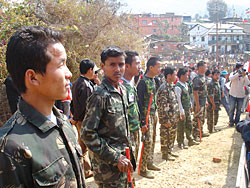 KUNDA DIXIT GATE TO AUTONOMY: The gate to Phidim welcoming visitors to Limbuwan |
The meal-stop highway settlement of Ranke looked placid enough this week, with passengers waiting for buses or buying fruits from sidewalk vendors.
The calm was suddenly shattered by a brawl between rival Limbuwan activists who came to blows over a turf war concerning highway taxes. "Things look peaceful, but beneath the surface the tension can snap at any moment," says a Phidim-based civil servant.
The epicentre of the struggle by Limbu activists for self-determination and autonomy is in the Panchthar capital of Phidim. The gate of the town is painted over with a 'Welcome to Limbuwan' sign and 'Panthar' and 'Phenden', the original Limbu names for Panchthar and Phidim. There is graffiti along the highway warning 'long noses' to keep off.
Dozens of Limbu groups demanding everything from autonomy to separatism have taken up the flag of identity politics. No one dare be left behind.
Some, like the Sanghiya Limbuwan Rajya Parisad led by Kumar Lingden and ex-airline pilot D K Buddhist want a federal autonomous Limbuwan province within the borders of Nepal. Then there are groups like Pallo Kirat led by ex-RPP Dambar Lawoti and Samjuhang Palungwa's Federal Limbuwan State Council who say they will wage a separatist war for a free Limbuwan state if their demands for self-determination are not met.
Lingden's gripe is that the government had not kept its promise to put the autonomy demands of the Limbuwan and other ethnic groups in the CA agenda.
"We have a one-point demand, which is the Limbuwan autonomous state," he told Nepali Times. He denied federalism would lead to separatism, and said the new federal unit would respect the rights of non-Limbus.
The independent Limbu nation is said to cover nine present districts to before Prithbi Narayan Shah's "Gorkha war of expansion". Activists here refuse to call it "unification", and one argument is that because the Limbu nation had submitted to the Gorkha king, the understanding is now off since the monarchy is no more. The separatist rhetoric is now staple fare in speeches and workshops here, and in broadcasts of Sumhatlung FM, inaugurated last week by CA chairman Subhas Nembang.
What worries non-Limbus in Phidim is that Limbuwan activists, many of them ex-Maoists, are using the same tactics as the Maoists did during the conflict: threats, extortion and public punishments. So pervasive is the fear that no one we spoke to in Panchthar this week wanted to be quoted by name, and most lowered their voices and looked over their shoulders.
 LAXMI GAUTAM Limbuwan militia guard their leaders at the national convention of the Federal Limbuwan State Council in Phidim. |
Journalists here admit they self-censor dispatches because of the fear of retribution. The Kantipur correspondent here had his motorbike set on fire by Limbuwan activists last month, and the police refused to register his complaint. The police have learnt the hard way to lie low. When they confiscated a khukuri from a Limbuwan militant in Phidim recently, agitators surrounded the station and forced police to not just return the knife but to apologise.
Civil servants, civil society and non-Limbus are worried that a spark could set off tit-for-tat ethnic violence. Everyone remembers the last turmoil in this region in the 1950s after the fall of the Ranas, when there was an exodus of hill Parbate and others down to Jhapa. With groups competing to lead the movement by being more hardline, a solution looks difficult. When a five-point agreement was signed last year between Palungwa's group and the government, a copy of the accord was set on fire the next day in Phidim by his student supporters.
Human rights activists have been surprised by how fast things have deteriorated here. Some blame the Maoists for promoting ethnic state councils and then using them during last year's elections as vote banks. "What should have been political representation within the state structure was given a colonial flavour," explains human rights activist Sushil Pyakurel. "It's only a small step from calling yourself a liberation front to having a separatist agenda."
Indeed, many analysts believe the Maoists are now finding it difficult to put the ethnic genie they unleashed back into the bottle, even as activists have begun to point out that the top three Maoist leaders are Bahuns. Ethnic militancies that have erupted in the past three years are all Maoist splinter groups.
Eastern Nepal today could also be an indication of what lies in store if the debate over federalism in the new constitution cannot be contained within the CA. Ethnic Limbus in the mainstream parties can't afford to be anti-Limbuwan, and the dilemma is that most moderate intellectuals are non-Limbu.
Clashes broke out recently in Phidim between supporters of the Limbuwan Rajya and the Kirat Rajya of the Rais, whose territorial claims overlap. There is also muted opposition from some Lepcha (Rong) and Bhotiya people who live in the north.
Says a Rai teacher here: "It's not just the Bahun and Chettris who are feeling insecure, it's getting dangerous even for us Rais and for Magars and Newars."
And no one is even talking about what would be India's take on all this, as some militants say the Limbuwan state should even include Sikkim and Darjeeling, where the Limbu are known as Tsong.
Additional reporting by Dewan Rai in Kathmandu
See also:
'Rebel rebellion', # 438 by JB Pun


